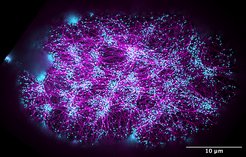Rotating forces get embryos in shape
Dresden researchers discover how a protein creates the rotatory forces essential for animal development.
Our body appearance is symmetric from the outside. If you take a look inside, you will find our organs are not at all arranged symmetrically. The heart, for example, is on our left side. These differences in structure, referred to as left-right asymmetry, emerge very early during the development and are crucial for an embryo to properly grow. Researchers have found in past studies that rotatory forces, so-called torques, play an important role to create the left-right asymmetry, thereby shaping cells and organs. Now, scientists from the Max Planck Institute of Molecular Cell Biology and Genetics, the Biotechnology Center of the TU Dresden, and the Cluster of Excellence Physics of Life at the TU Dresden identified the proteins involved in the generation of torques and explained their interaction.

A developing organism needs axes for orientation: Where is the top and the lower part of the body, where the back and the front? A third axis defines where the left and the right side goes. While the outside of our body is overall left-right symmetric, our internal organs are arranged left-right asymmetrically. This left-right asymmetry arises already during the early development of an embryo, and can even be observed within individual embryonic cells. Cellular left-right symmetry breaking depends on the cell cortex – a fine network of actin filaments and myosin motor proteins just below the cell membrane. In response to Myosin motor activity, the cortex undergoes cellular-scale movements, or flows, and sets itself in motion in a collective manner. Interestingly, the cortex undergoes a rotational movement: the opposite halves of embryonic cells rotate in opposite directions.
In turn, these opposite rotations cause the tilting of some cells, and thus lead to the breaking of the left-right symmetry of the entire organism. This mechanism was identified in past studies by the research lab of Stephan Grill, who is a director at the Max Planck Institute of Molecular Cell Biology and Genetics and speaker of the Cluster of Excellence Physics of Life.
Proteins generate rotatory forces
From physics we know that rotatory movements arise in response to rotatory forces or torques. What was not known so far, is which molecules are responsible for actively generating the rotatory forces that facilitate counter-rotations, and how they do this? The postdoctoral researcher Teije Middelkoop in the group of Stephan Grill worked together with researchers from the California Institute of Technology (Caltech), USA and the Massachusetts Institute of Technology (MIT), USA to address this question. Teije Middelkoop suspected that two groups of proteins are involved in creating torques: Formin proteins that help to generate actin filaments and Myosin motor proteins that pull on actin filaments. Because actin filaments are molecular cables with a right-handed helical twist, both these proteins could in principle generate molecular scale rotatory forces, but whether and how these two protein types interact was unclear. Teije Middelkoop explains: “By performing fluorescent confocal microscopy, we found that counter-rotating flows in the cortex of the Caenorhabditis elegans roundworm increased when there was more Formin available. Once we reduced the amount of Formin in the roundworm or removed it completely, we also saw less torques in the cortex.”
Moreover, the researchers found out how Myosin and Formin cooperate: While Myosin is required to trigger the necessary cortical movements, analogous to the engine of a car, Formin acts like a steering wheel and ensures that the forces generated by myosin cause rotating flows and cell movements. Stephan Grill summarizes: “These findings are another example of bridging physics and biology that has long been done in an ideal way here in Dresden. We have biologists and theoretical physicists on campus who are able to provide an interdisciplinary approach to the physics of biological processes. And the exciting thing about this study is that we now understand the physical forces and torques underlying embryonic growth a bit better.”












